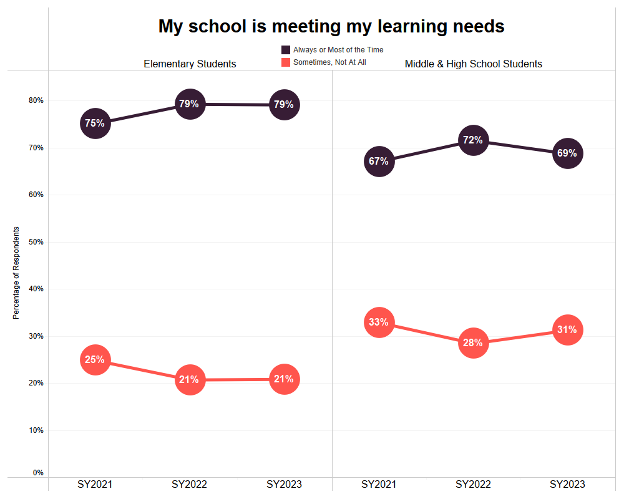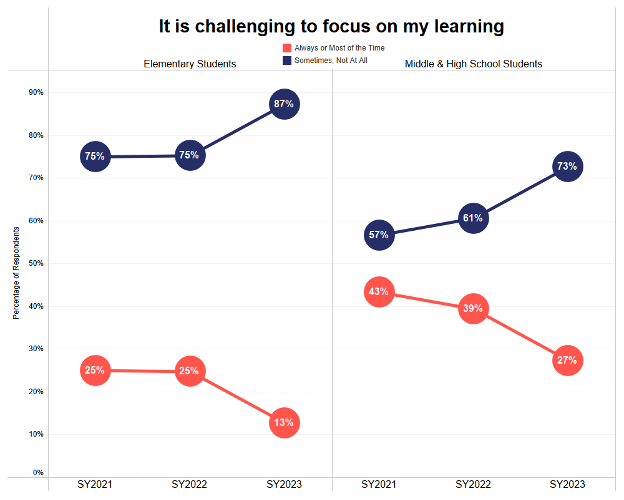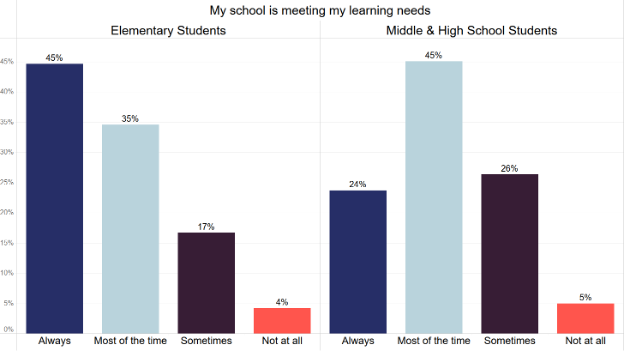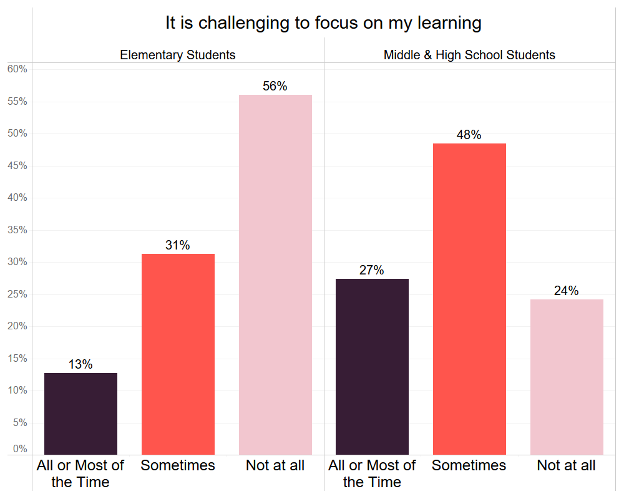As students begin a new school year, many find themselves in a familiar setting. Students, teachers, schools, and families are getting back into their normal school routines after a summer break, each bringing their own excitement and challenges.
New Year, New Challenges
As students begin a new school year, many find themselves in a familiar setting. Students, teachers, schools, and families are getting back into their normal school routines after a summer break, each bringing their own excitement and challenges. To help schools anticipate what to expect, Cognia created the Back-to-School Readiness (BTSR) surveys to gather perceptions of students, teachers, and parents. These surveys provide an opportunity for parents and students to express their readiness to transition back to school and provide a voice for teachers on their readiness to begin another school year.
Data from two items on Cognia’s BTSR Surveys for students are summarized here. The first summaries, displayed in Figures 1 and 2, highlight perceptions of how well schools are addressing individual students’ learning needs and students’ ability to focus on their learning needs from August 26, 2020, through October 14, 2022. Figures 3. and 4. show responses received since the beginning of the 2022–2023 school year on the same questions, for a closer look at how prepared students are for the 2022–23 school year.
Results of these surveys can give educators insight into opportunities to address the challenges that students face in returning to school and can suggest ways to support them and their families. The data are available to schools and organizations in the Cognia Global Network.
Overall and Over Time
Respondents completed one of two age-appropriate survey versions: one for elementary students (grades 3–5) and one for middle and high school students (grades 6–12). The items are similar on both versions. The differences between the two age groups reflected a marked difference in experience. Data in this section includes responses from 56,590 students from 441 schools across Cognia’s global network.
One item asks students if the school is meeting their learning needs, with four response options ranging from “Always” to “Not at All.” Since the 2021 school year (SY2021), the percent of both student populations selecting “Always” or “Most of the time” has increased. In particular, elementary students report higher percentages both overall and over time.
Figure 1. Meeting learning needs over time

Another question on the survey asks students about their ability to focus, upon returning to a new school year with new expectations. The impact was considerable over the last two school years, but the data shown below offer a positive insight that a higher percentage of students can focus this year compared to prior years.
Figure 2. Learning focus over time

This Year: Learning Needs
When students enter the classroom, they bring their unique experiences that prepare them to develop new abilities and skills—and they also bring personal challenges that may limit their learning opportunities. The data on student perception of their learning needs reveal differences between the grade ranges. In grades 6–12, only one out of four students (24%) reported that their learning needs are always met by their school, compared to nearly half (45%) of students in elementary grades.
Figure 3. Meeting Learning Needs 2022–2023

The data also show reasons for concern: 21% of elementary students and 31% of middle and high school students indicated that their needs are met only sometimes, or not at all. The responses are more favorable this year compared to previous years, though plenty of students feel there’s room to grow in how schools are addressing their learning needs.
This data should come as an alert that many students may feel discouraged or left behind. Educators interpreting this student data should avoid lowering expectations of academic achievement and engagement in the classroom at a time when students most need encouragement and support.
This Year: Student Focus
Figure 4 illustrates how students have adjusted to new expectations upon returning to school. For some students, instruction in 2021–2022 could have involved a mix of remote or in-person classes and Fall 2022 marked the return to classroom learning. Regardless of the instructional setting, the loss in learning progress over recent years is well documented, so students are additionally tasked with returning to new learning environments to make up lost ground.
Figure 4. Learning focus 2022–23

According to these students in Cognia’s network, middle and high school students find it challenging to focus this year, with more than one-quarter (27%) of students indicating it is a challenge all or most of the time. By contrast, only one in eight elementary students (13%) reported a similar challenge, suggesting that new or evolving policies at schools have less impact on younger students.
Given that slightly more than half (56%) of elementary students report that they are not at all impacted, a significant percentage of these students do feel the impacts on their learning and focus. Results from the beginning of the 2022–23 school year show students can focus much better than during the previous two years.
Preparing Schools
These voices represent students in schools and systems that are a part of Cognia’s diverse improvement network, including public and private institutions, U.S.-based and international schools, religious organizations, and corporations. Cognia’s BTSR surveys are currently available to all member institutions in our school improvement network. Schools and systems are encouraged to administer the BTSR surveys. When reviewing the data and considering actions, keep these guidelines in mind.
- Prepare students and educators to learn and focus as school policies and protocols continually evolve.
- Treat students with dignity and patience as they rejoin the learning community and provide them with opportunities to engage with their learning.
- Maintain awareness of varying student experiences (such recent instructional environment, access to learning resources, and the like) to exercise flexibility and a range of strategies to minimize disrupted learning.
- Provide teachers with professional development focused on identifying student learning needs, tools and methods for monitoring progress, and strategies that help inform instruction in the classroom.
Many students and educators were faced with significant challenges and disruptions, beginning with the Covid-19 pandemic, and continuing as society and education adjusted to a “new normal.” Each new school year provides a fresh opportunity to understand where students are and to determine the best path forward.
© Cognia Inc.
This article may be republished or reproduced in accordance with The Source Copyright Policy.
The information in this article is given to the reader with the understanding that neither the author nor Cognia is in engaged in rendering any legal or business advice to the user or general public. The views, thoughts, and opinions expressed in this article belong solely to the author(s), and do not necessarily reflect the official policy or position of Cognia, the author’s employer, organization, or other group or individual.

